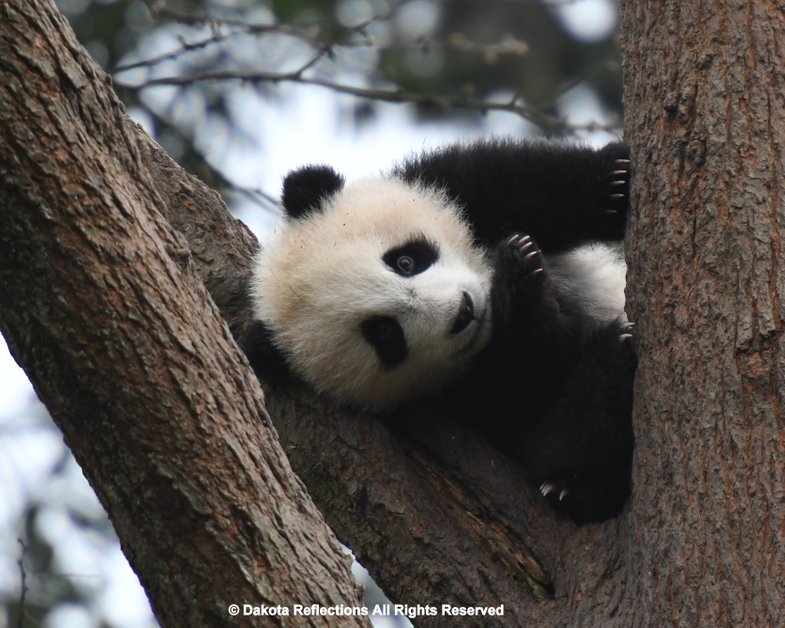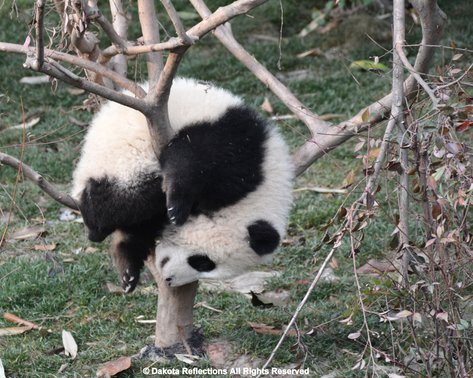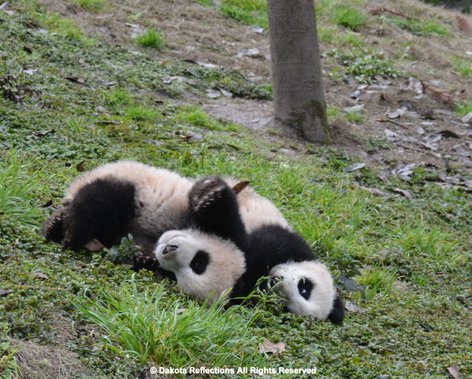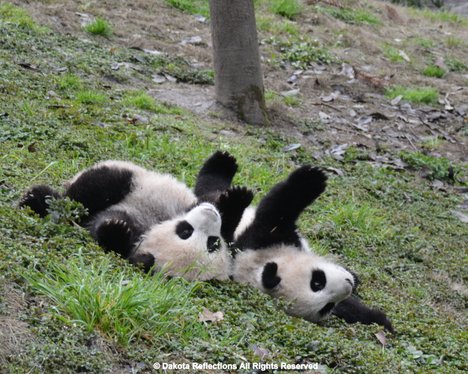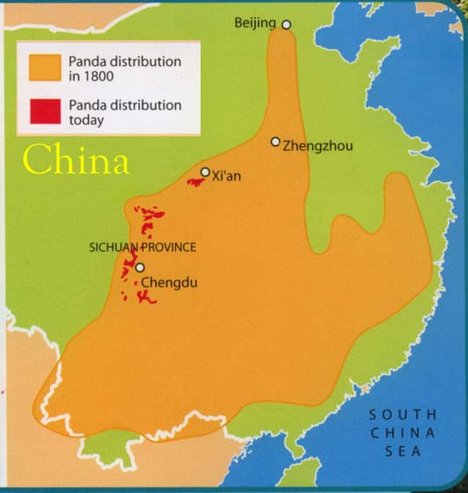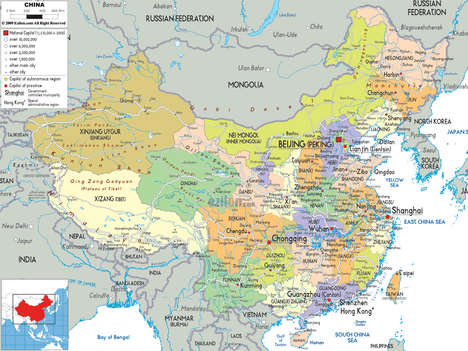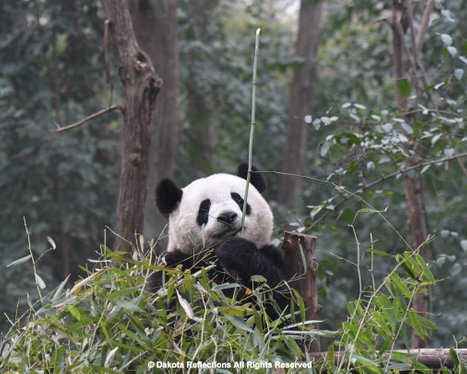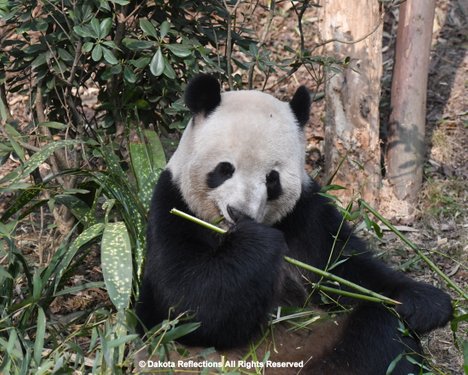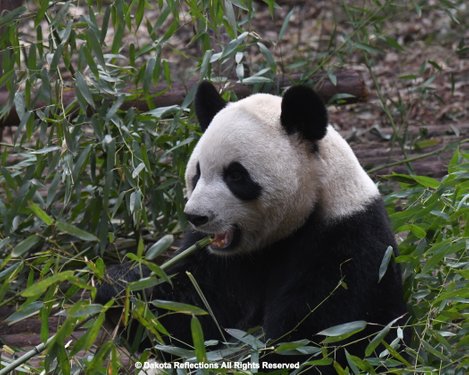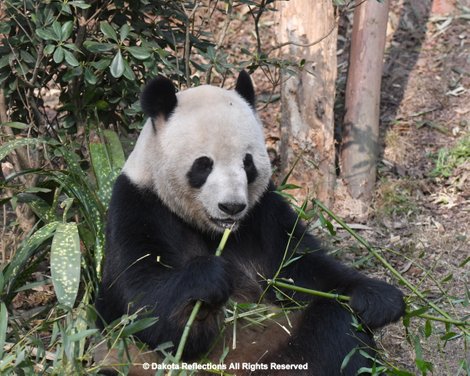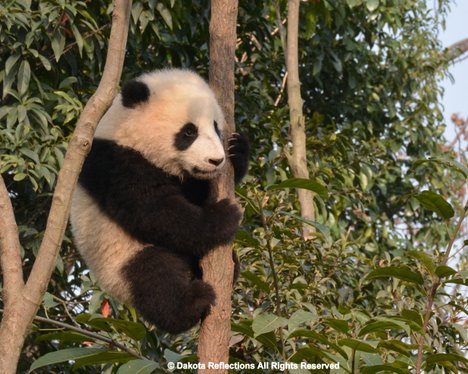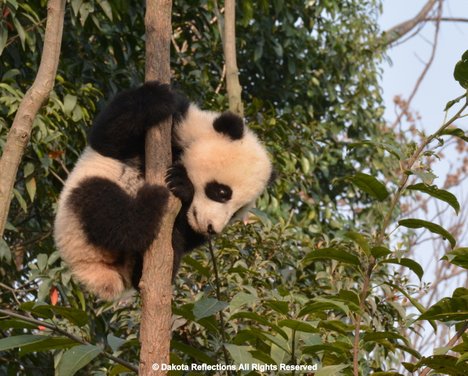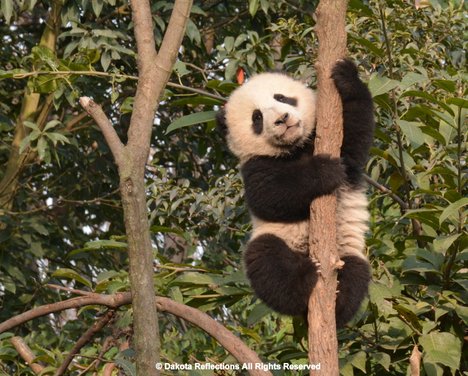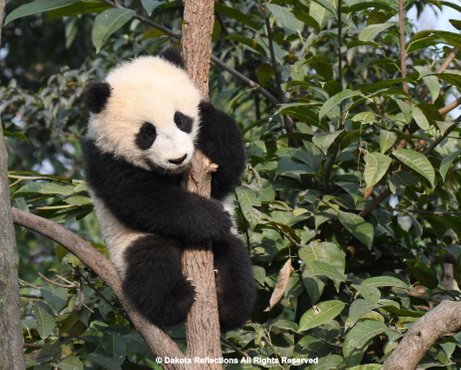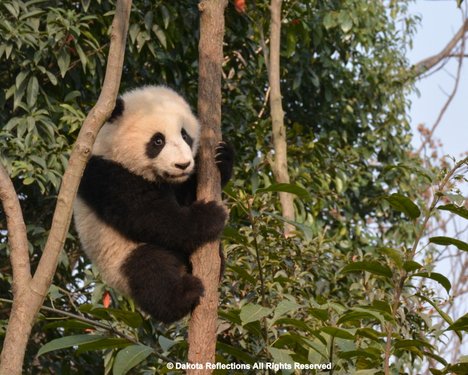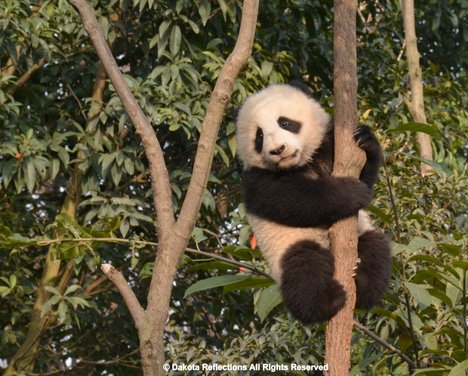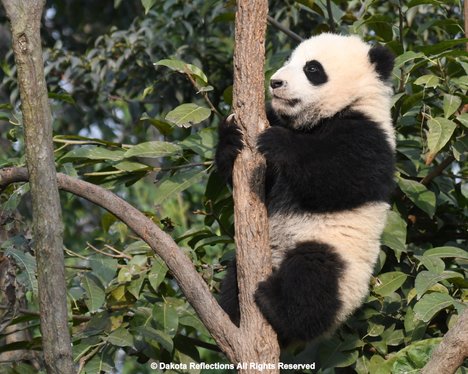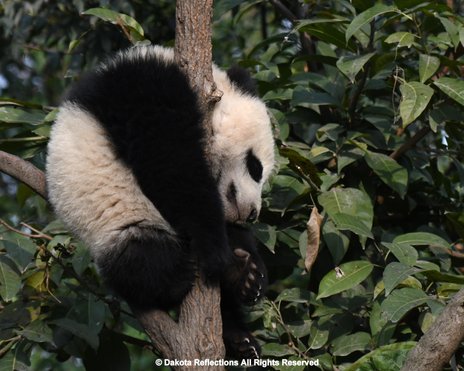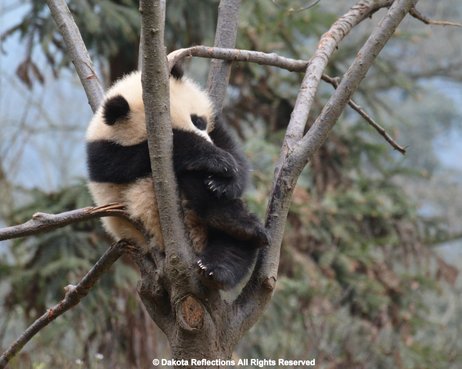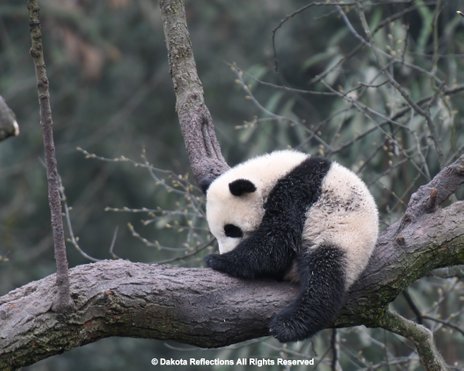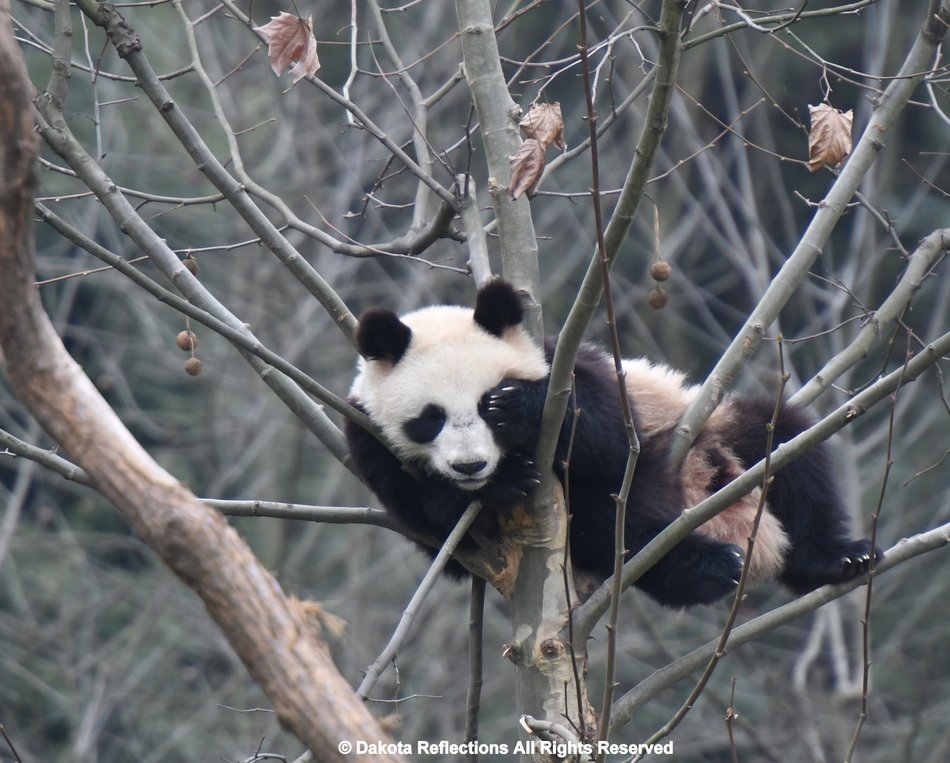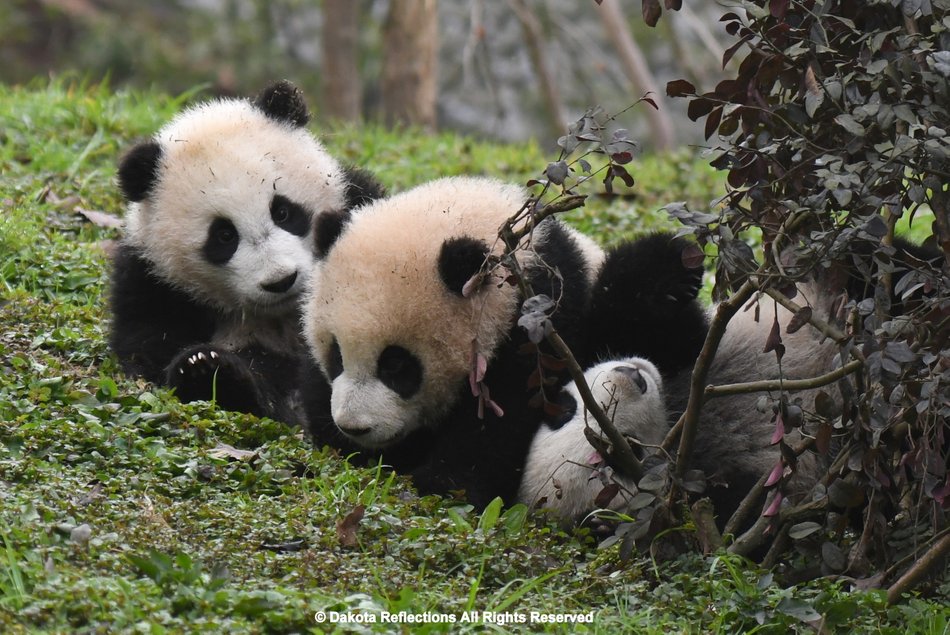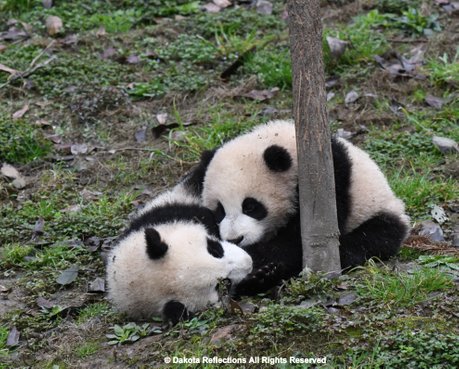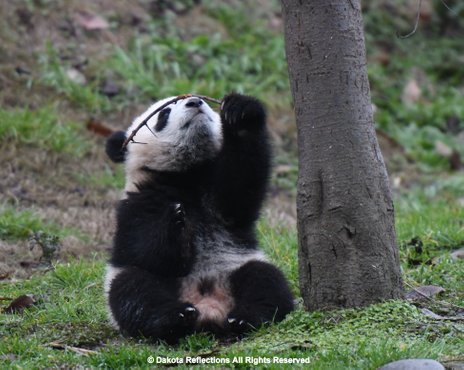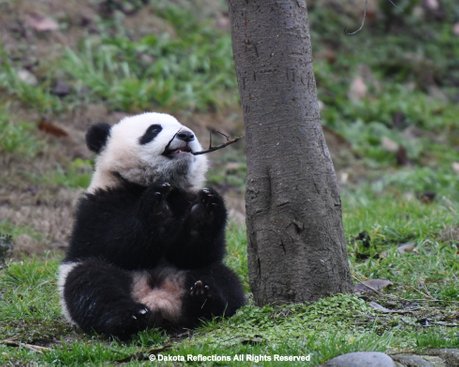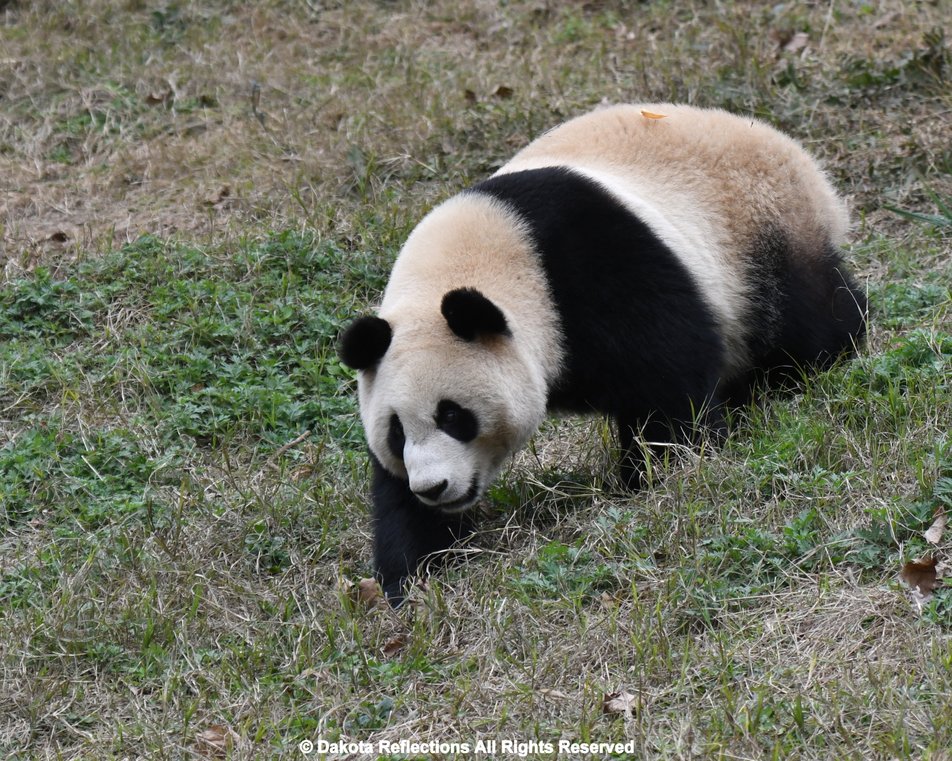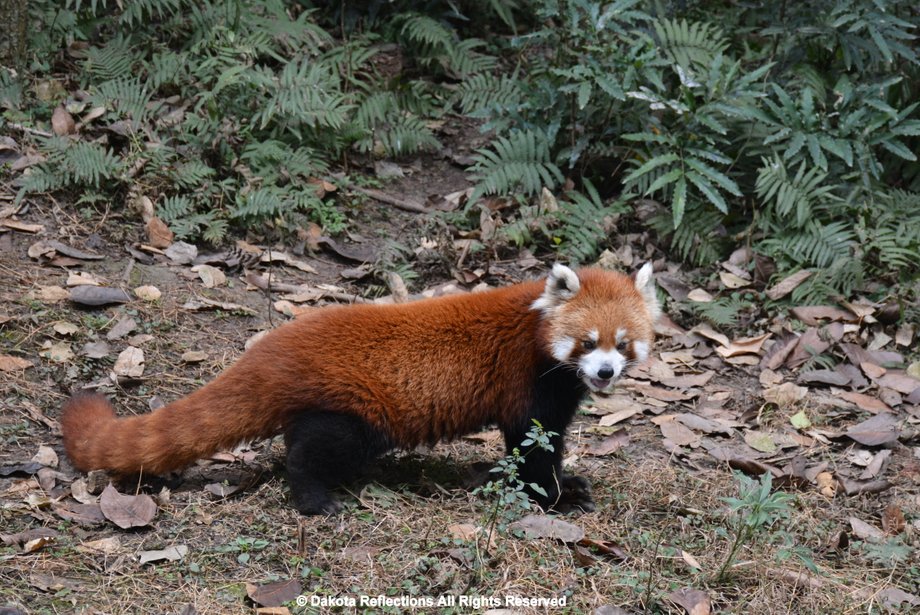Dakota Reflections
Pandas of China
Pandas in China and Their Habitats
The Giant Panda is a species of bear found in China. The giant panda probably evolved into a seperate species around 3 million years ago. Although considered a bear, the giant panda has a number of distinguishing chararactistics different from many bears:
Vegetarian diet almost confined to eating bamboo
Opposable thumb and 5 claws (thumb is actually an evolved wrist bone)
Very round head
Black and white coloring
Relative slowness (20 mph)
Large amount of time spent in trees
Do not hibernate or spend time in dens (prefers trees and caves)
Most other animals can't eat bamboo due to thickness of bark or splintering but the giant panda has sharp teeth, a strong jaws and a thick esophagus
Not as territorial as other bears and will tolerate other giant pandas in the area
Usually females will have one cub, if twins, one will likely be rejected
Females go into heat only 2 to 5 days each year
Have the shortest gestation (2 to 3 months) of any bear (most other bears- 6 months) and have the smallest babeis (3 to 4 ounces) compared to other bears (10 to 13 ounces)
Lives up to 14 to 20 years in the wild, more than 30 years in captivity
Why are Giant Pandas so Appealing to Humans?
Their physican and behavioral characteristics remind us of human babies:
Their snub noses
Generous cheeks
Toddling gaits
Supersized eyes
Black patches around eyes
Pseudo-thumb
Stand on their hind legs
Somersault.
Reference: Abigail Tucker, The Science Behind Why Pandas Are So Damn Cute:There’s a reason why millions adore these furry exemplars of China’s “soft power” Smithsonian Magazine, November 2013
Giant Panda Cub Climbing and Falling from a Tree
Giant Panda Cubs Rolling Down a Hill
Habitat Loss
The giant panda was once found in southern and eastern China and the countries of Myanmar and northern Vietnam. Habitat loss means that the giant panda is now found in six mountain ranges in China's Sichuan, Shaanxi and Gansu provinces.
Giant Pandas and Bamboo
Giant Pandas obtain 99% of their nutrition from bamboo, which is not all that nutritious and is very hard for animals to eat. Therefore, giant pandas have to eat a lot of bamboo, between 25 and 80 pounds a day. That takes a lot of time and these pandas can eat up to 14 hours in a day.
Scientists studied three male and three female pandas in the Qinling Mountains of China for 6 years and analyzed the amounts of nitrogen, phosphorous, and calcium in the plants they ate.
There are two type of bamboo in the Qinling Mountains: wood and arrow bamboo which grow at different altitudes and at different times of the year. Giant pandas prefer young wood bamboo spouts in the spring (a good source of nitrogen and phosphorus), young arrow bamboo spouts in early summer and in mid-summer switched to young arrow bamboo leaves (a good source of calcium- important when pregnant). After delivering their babies in August, the giant pandas return to lower elevations and eat young wood bamboo leaves which also have a lot of calcium.
Reference: Sandhya Sekar, How pandas survive on their bamboo-only diet, Science Magazine, a publication of the American Association for the Advancement of Science, Jul. 9, 2014
Why are Giant Panda Cubs Such Excellent Tree Climbers?
Within a couple of months of age, giant panda cubs become skilled at climbing trees. Although adult giant pandas have few predators other than humans, cubs need to have a quick escape to avoid predators such as jackals, snow leopards and yellow-throated martens. Giant panda cubs can't also be watched by their moms all the time because they spend nearly half their day eating!
Giant pandas have long, strong, hard and retractile claws and broad paws with furry undersides which help them climb trees. Adults don't spend a lot of time in trees but the cute cubs sure do!
Trees Make Great Places for Naps!
This Cub Found a Spot 100 Feet (30 Meters) Above the Ground!
The Keep One Eye Covered when Sleeping Technique!
Do Giant Panda Cubs Love to Play?
They Sure Do!
Should I Balance This Twig on My Nose?
Or Should I Eat It!
How Are the Chinese People Conserving the Giant Panda?
History
1974 China's first nationwide Giant Panda survey- estimated 2400 pandas
1978 Professor Hu Jinchu established the world's first Giant Panda observation center, Wuyi Shed, in the Wolong Nature Reserve in the Minshan Mountains
1980 the World Wildlife Fund became the first international organization to use the Giant Panda as its logo and donated $1 million to have establish the Wolong Giant Panda Ceter
1985 to 1989 China Giant Panda study showed only 1,100 pandas remained
1987 Chengdu Research Base of Giant Panda Breeding, or Chengdu Panda Base, started with 6 giant pandas that were rescued from the wild
September 7, 1991 two cubs born to Panpan and Dongdong at Wolong
1998 Chinese government began forest conservation program for pandas
2000 12 cubs born at the National Panda Conservation Research Center in Wolong
2003- third national Giant Panda survey- 1600 pandas in six mountain systems, 40 protected areas in China for Giant Pandas
2003- Xiangxiang first Giant Panda in captivity to be released into the wild, he died 2007
2004- Bifengxia Giant Panda Base opened
2005- 56 protected areas in China for Giant Pandas
2011- Dujiangyan Panda Base, located at Shiqiao Village, Qingchengshan Town opened
2014- 1,864 giant pandas in the wild and over 300 in captivity
September 2016 International Union for the Conservation of Nature (IUCN) upgraded the giant panda’s status from “endangered” to “vulnerable”
Giant Pandas in the United States
History
Lingling ("exquisite jade"- found as cub in 1971 Mahuang Valley) and Xingxing sent to the National Zoo, Washington, DC, did not have cubs that survived more than a few days
National Zoo in Washington, DC
Tian Tian ("more and more") arrived December 2000
Mei Xiang ("beautiful fragrance") arrived in December 2000
Babies:
Tai Shan (""peaceful mountain") born July 9 2005, first cub born at National Zoo to survive, returned to February 4, 2010 (on the same flight as Mei Lan from Zoo Atlanta), first to the Bifengxia Panda Base, in Ya'an, Sichuan and then in 2014 moved again to the Dujiangyan base of Sichuan Province's China Conservation and Research Center for the Giant Panda
Bao Bao ("treasure") female cub born Aug. 23 2013, returned to Duijiangyan Base (part of the China Conservation and Research Centre for Giant Pandas) on February 21, 2017,
Bei Bei ("precious" or "treasure") born August 22, 2015 names Bei Bei" by Michelle Obama and Peng Liyuan, the first ladies of the United States and the People's Republic of China
San Diego Zoo
Gaogao arrived in January 2003. He was found at 6 months of age in Wolong on April 6, 1993
Bai Yun
Babies:
Hua Mei ("China/USA") was born August 21, 1999 and was the first giant panda cub to survive to adulthood in the United States. She was born to Bai Yun (mother) and Shi Shi (father) at the San Diego Zoo. She was sent to Wolong, China in 2003 and then to Bifengxia after the 2008 earthquake and has had a total of 10 cubs
Mei Sheng ("Beautiful Life" or "Born in the USA") born August 19, 2003 is a male giant panda, first offspring of Bai Yun and Gao Gao, sent to Wolong, China on November 5, 2007. After the 2008 Sichuan earthquake, Mei Sheng was relocated to Bifengxia Panda Base, just outside Ya'an. had one cub, Shu Qing, with Ying Ying
Su Lin Su Lin (Beautiful Jade") a female cub born on August 2, 2005. conceived via natural mating, Su Lin and her sister Zhen Zhen were sent to Bifengxia Panda Base in China on September 24, 2010
Zhen Zhen ("Precious") is a female cub born August 3, 2007 and sent to Bifengxia Panda Base in China on September 24, 2010
Yun Zi ("Son of Cloud (Yun)") male cub born on August 5, 2009 and weighed 4 ounces and was returned to China in January 2014 and lives at Dujiangyan Base (part of the China Conservation and Research Centre for Giant Pandas)
Xiao Li Wu ("little gift") a male cub born July 29, 2012
Zoo Atlanta
Lun Lun
Yang Yang ("Nine Nine, born 9/9/1999)
Babies:
Mei Lan ("Atlanta Beauty") male cub born on September 6, 2006, after a record-setting 35-hour labor, originally identified by zoo staffers as female, Mei Lan was determined to be male by staff in China at the Chengdu Research Base of Panda Breeding, sent to Chengdu, China on February 4, 2010
Xi Lan ("Atlanta's joy") is a male cub born August 30, 2008 and currently residing at Zoo Atlanta
Po, a female cub, born 3 November 2010 and was sent to the Chengdu Research Base of Giant Panda Breeding
Mei Lun and Mei Huan, were the first surviving pair of giant panda twins ever born in the U.S. and were sent to Chengdu Research Base of Giant Panda Breeding on November 3, 2016
Mei Huan born July 15, 2013- see above
Ya Lun ("Lun Lun's elegant and happy daughters") female twin cub born September 3, 2016
Xi Lun ("Lun Lun's elegant and happy daughters") female twin cub born September 3, 2016
Memphis Zoo
Ya Ya ("beautiful little girl") and
Le Le ("happy happy") arrived in Memphis from Beijing together in April 2003, no babies yet
References:
Fang Min, The Giant Panda, Better Link Press, Shanghai Press and Publishing Developing Company, Shanghai, China, 2011
Susan B. Barnes, Where to find giant pandas in the US, USA TODAY, September 18, 2014
wikipedia- giant panda
There is another Panda in China- The Red Panda!
Red pandas are not related to the Giant Panda and are considered living fossils because no other animal is closely related. Red pandas' somewhat nearest relatives are weasels, raccoons and skunks. Red pandas share several characteristics with giant pandas: overlapping habitat, bamboo in the diet and the modified wrist bone that serves as a thumb.
Red pandas have five toes that are widely separated and semi-retractable claws. They share the giant panda's "thumb:" a modified wrist bone—that is used to help grasp bamboo when feeding.
Red pandas can be found in northern Myanmar (Burma), west Sichuan and Yunnan Provinces of China and in Nepal, India and Tibet in high altitude temperate forests.
Approximately 10,000 red pandas are left in the world and they are considered a vulnerable species.
"Saving Giant Pandas with San Diego Zoo Global!" Webinar by San Diego Zoo Global, Wednesday, March 15, 2017
Brief Overview of San Diego's Giant Panda Program
Story of hope, if we work together can save species from extinction.
Understanding genetics
Behavioral biology
Reproductive biology- giant pandas are solitary animals and getting together can be difficult
Building relationships with collegues in China
Conservation Takes Time
At two weeks of age, the black color shows up on panda cubs in the skin as pigmentation then the fur changes color.
They eat 14 hours a day and poop up to 50 times a day.
Large bamboo die off in 1970s accompanied by habitat fragmentation lead to the crash in giant panda numbers.
In mid 1990s, captive population was not doing well 100 in captivity and only 40 percent females were having babies and only 7 breeding males were in China. Now, over 400 are in captivity, 80% females are reproducing.
Pandas use vocalizations and scent to communicate during mating. Scent marking occurs 2 weeks prior to mating then vocalizations start about 1 week prior to mating.
Community of giant panda researchers. Excellent communication with Wolong and exchange of researchers.
Bai Yun has been a perfect panda. Very good mom and good relationship with Gao Gao who is an amazing breeder.
What does it mean to be a good panda mom. Used video and audio to record activity in den. Giant pandas are fascinating to observe, start off as helpless cubs who go under significant changes, including how to eat bamboo of cub watching mom eat bamboo.
Bifengxia is the primary breeding facility- 20 cubs per year. Wolong is changing to more of a release into the wild facility.
Greatest change in panda recovery has been habitat preservation.

